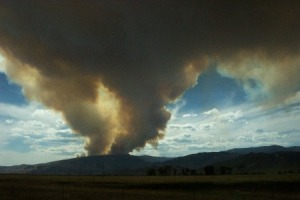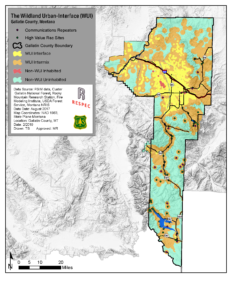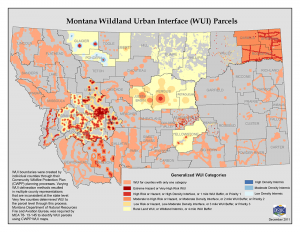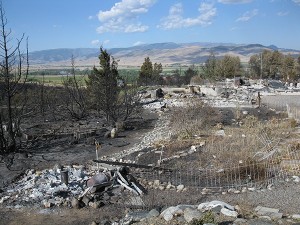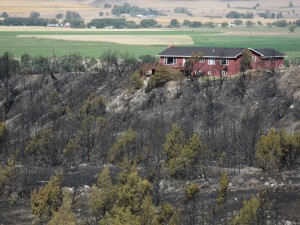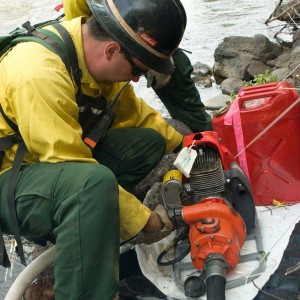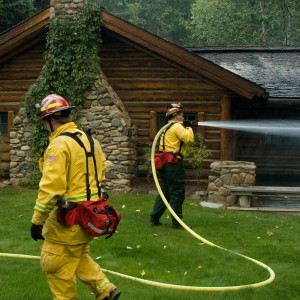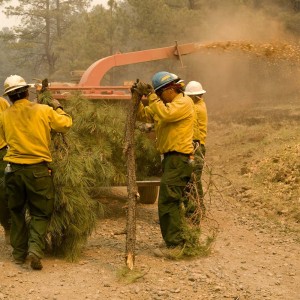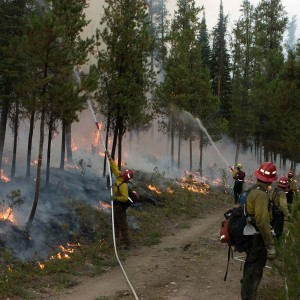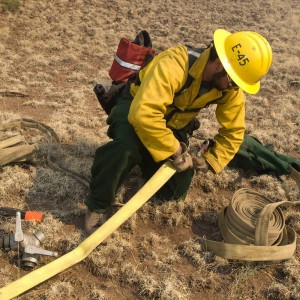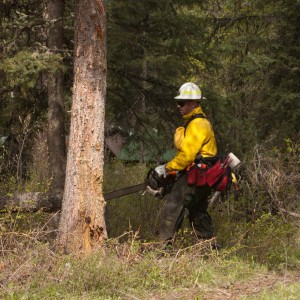In Gallatin County many residences are considered to be in the Wildland Urban Interface. This means that these residences are identified as being at risk from wildfires. Even if you don’t live in a mapped Wildland Urban Interface area, your home could still be at risk. Through a little effort on the homeowners part, their risk to wildfires can be decreased. The information on this page will provide homeowners a variety of information on how they can help reduce the damage done to their house in a wildfire.
The Wildland Urban Interface (WUI) is commonly described as the zone where structures and other human development meet and intermingle with undeveloped wildland or vegetative fuels. WUI areas exist in many areas throughout Gallatin County. Many projects are underway by various organizations to mitigate the risk in the WUI around Montana. Information about identified projects in Gallatin County can be obtained from the Gallatin County Community Wildfire Protection Plan. Anyone can benefit from making your house resistant to fire, regardless of where you live.
What Can I Do?
There is a lot you can do!
With a few actions you can help prevent a wildfire from starting, or getting out of control. With a little more time and effort you can help increase the chances that your house will survive if exposed to a wildfire (or any fire!). Continue reading below for information and resources on how you can do this:
Prevention Activities
Debris Burning / Controlled Burns
Thousands of controlled burns are conducted in Gallatin County each year on different scales. Most of these meet there objective with no unintended consequences, however some do escape and cause harm. Follow these tips to help you burn be successful and safe:
- Always activate a burn permit at gallatinburnpermits.com. If open burning is closed when you try to activate your permit, then you shouldn’t be burning. While it may not always be obvious why burning is closed, there is always a good reason (like expected weather) and you should not be starting a fire. Burn permits also help everyone know if a column of smoke is supposed to be there or not, thus saving police and fire running around the valley all day to controlled burns.
- Always have bare dirt around what you are burning and have water available to control your burn if it starts getting too big. You need to have the necessary tools to ensure the fire is kept controlled.
- Make sure that you know the weather forecast for the day. Nice summer days are the same conditions that help controlled burns escape. Be leery of expected winds, expected fronts, or forming thunderstorms. Find the weather at weather.gov/greatfalls.
- Always stay with the fire until it is completely out, never leave it unattended. Dig around in the fire while adding water to make sure it is completely out.
Camp Fires
Make sure your campfire is dead out. If it is too hot to touch, then it is too hot to leave. Using a shovel, stir water and dirt into your campfire to make sure everything is wet and cold to the touch.
Lawn and Farm Equipment
Lawn and farm equipment caused wildfires are very common. Just one small spark can ignite dry grass. Use spark arrestors on ALL portable, gasoline-powered equipment; including tractors, harvesters, chainsaws, weed-eaters, mowers, motorcycles and all-terrain vehicles. Be cautious when operating in, or mowing, cured grass as it can easily catch fire.
Dragging Equipment
Take the time and make sure your vehicle is properly maintained, with nothing dragging on the ground. A loose safety chain on a trailer or a dangling muffler striking a rock or pavement will send a shower of sparks into dry vegetation.
Fireworks
The tip of a sparkler burns at a temperature of more than 1,200 degrees Fahrenheit, which can easily ignite the dry vegetation. The safest way to enjoy fireworks is to attend a public display sponsored by your local community.
Target Shooting
Certain types of ammunition can ignite a wildfire. Take the time to clear an area around your target and avoid dry grass and flammable materials as you shoot.
Home Preparedness
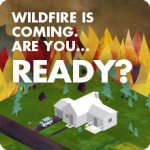
On a basic level any homeowner can, and should, do these simple tasks. You never know when a house will be exposed to fire, even in a subdivision or city. These simple actions will help protect your house:
- Create an emergency plan and practice it with family members.
- Clean out gutters, roofs and other areas where debris has settled (remove stuff that can easily catch fire, then set your house on fire).
- Keep the space around your home clear of dense vegetation (minimize plants that can easily catch fire and then set your house on fire).
Ready, Set, Go!
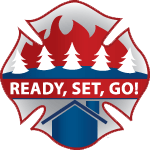 Ready, Set, Go! is a program created by the International Association of Fire Chiefs to help people prepare. RSG splits activities into the following steps:
Ready, Set, Go! is a program created by the International Association of Fire Chiefs to help people prepare. RSG splits activities into the following steps:
- Ready – Develop a plan and work to make your home fire resistant.
- Set – A fire is in the area, put you plan in place and prepare to leave.
- Go – Leave early when there is time so you don’t get caught in the fire fight.
Numerous studies and real life incidents have shown that a little work on the front end will dramatically increase the chance that your house will survive being exposed to fire. Once a wildland fire starts in your neighborhood it is often too late (not enough time or resources) to perform the simple steps that will help your home survive. While many people feel it will never happen to them, a little time planning before a fire occurs will provide the comfort in knowing that if you are exposed to a fire, the changes are much higher that your home will survive. Wildfires can happen anywhere and if you live in an area with natural vegetation around your home, you should assume a wildfire could occur where you live!
To learn more about Ready, Set, Go! read our Ready, Set, Go! Montana Guide specific to us here in Montana.
Living With fire
Living with Fire was created in 2009 by Fire Safe Montana and provides valuable information on preparing your home to have the highest chances of surviving a wildfire. Common terminology between Living With Fire and Ready, Set, Go! Montana Guide has been utilized so these guides compliment each other.
- Setting up Pumps
- Preparing a House
- Reducing Fuels
- Holding a Fire
- Connecting Hoses
- Clearing Trees
Gallatin County Fire Protection Districts
Wildfire Preparedness Resources
Multimedia Resources


